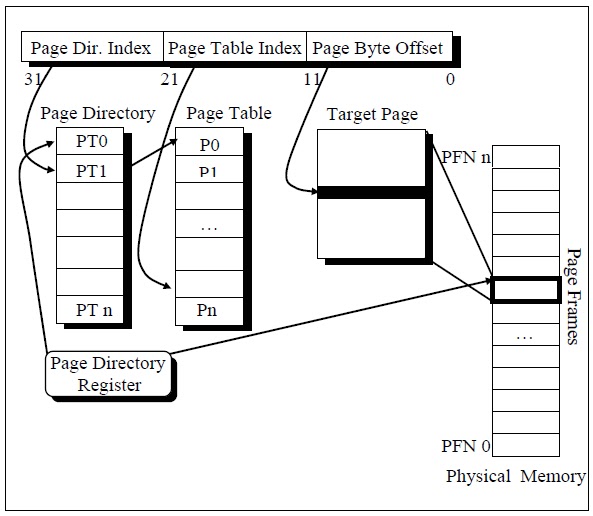Since users have become more demanding, modern day applications have to contend with these demands and provide several features in them. To add to this, under Windows several such applications run in memory simultaneously. The maximum allowable memory—1 MB—that was used in 16-bit environment was just too small for this. Hence Windows had to evolve a new memory management model. Since Windows runs on 32-bit microprocessors each CPU register is 32-bit long. Whenever we store a value at a memory location the address of this memory location has to be stored in the CPU register at some point in time. Thus a 32-bit address can be stored in these registers. This means that we can store 232 unique addresses in the registers at different times. As a result, we can access 4 GB of memory locations using 32-bit registers. As pointers store addresses, every pointer under 32-bit environment also became a 4-byte entity.
However, if we decide to install 4 GB memory it would cost a lot. Hence Windows uses a memory model which makes use of as much of physical memory (say 128 MB) as has been installed and simulates the balance amount of memory (4 GB – 128 MB) on the hard disk. Be aware that this balance memory is simulated as and when the need to do so arises. Thus memory management is demand based.
Note that programs cannot execute straight-away from hard disk. They have to be first brought into physical memory before they can get executed. Suppose there are multiple programs already in memory and a new program starts executing. If this new program needs more memory than what is available right now, then some of the existing programs (or their parts) would be transferred to the disk in order to free the physical memory to accommodate the new program. This operation is often called page-out operation. Here page stands for a block of memory (usually of size 4096 bytes). When that part of the program that was paged out is needed it is brought back into memory (called page-in operation) and some other programs (or their parts) are paged out. This keeps on happening without a common user’s knowledge all the time while working with Windows. A few more facts that you must note about paging are as follows:
Note that programs cannot execute straight-away from hard disk. They have to be first brought into physical memory before they can get executed. Suppose there are multiple programs already in memory and a new program starts executing. If this new program needs more memory than what is available right now, then some of the existing programs (or their parts) would be transferred to the disk in order to free the physical memory to accommodate the new program. This operation is often called page-out operation. Here page stands for a block of memory (usually of size 4096 bytes). When that part of the program that was paged out is needed it is brought back into memory (called page-in operation) and some other programs (or their parts) are paged out. This keeps on happening without a common user’s knowledge all the time while working with Windows. A few more facts that you must note about paging are as follows:
(a) Part of the program that is currently executing might also be paged out to the disk.
(b) When the program is paged in (from disk to memory) there is no guarantee that it would be brought back to the same physical location where it was before it was paged out.
Now imagine how the paging operations would affect our programming. Suppose we have a pointer pointing to some data present in a page. If this page gets paged out and is later paged in to a different physical location then the pointer would obviously have a wrong address. Hence under Windows the pointer never holds the physical address of any memory location. It always holds a virtual address of that location. What is this virtual address? At its name suggests it is certainly not a real address. It is a number, which contains three parts. These parts when used in conjunction with a CPU register called CR3 and contents of two tables called Page Directory Table and Page Table leads to the actual physical address. This is shown in Figure
The CR3 register holds the physical location of Page Directory Table. The left part of the 32-bit virtual address holds the index into the Page Directory Table. The value present at this index is the starting address of the Page Table. The middle part of the 32-bit virtual address holds the index into the Page Table. The value present at this index is the starting address of the physical page in memory. The right part of the 32-bit virtual address holds the byte offset (from the start of the page) of the physical memory location to be accessed.
Note that the CR3 register is not accessible from an application. Hence an application can never directly reach a physical address. Also, as the paging activity is going on the OS would suitably keep updating the values in the two tables.
Note that the CR3 register is not accessible from an application. Hence an application can never directly reach a physical address. Also, as the paging activity is going on the OS would suitably keep updating the values in the two tables.


No comments:
Post a Comment